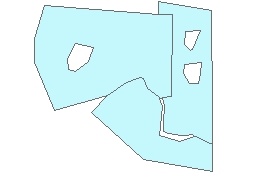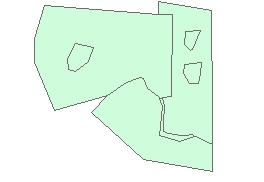
Finds the gaps between polygons and holes within polygons and fills them with new polygons.
Before Clean Gaps

After Clean Gaps

Parameters
| Expression | Explanation |
|---|---|
| Function Name | CleanGaps |
| <input dataset> | A String representing the input layer. Must be of Polygon type. |
| <output dataset> | A String - the full name of the output layer. |
| {Clean Polygons} | A Bollean indicating whether the function to clean the polygons from overlaps. |
| {Fuzzy Tolerance} | A Double representing the Fuzzy Tolerance. |
ETGWPath used in the table below is the full path to ETGWRun.exe (E.G. "C:\Program Files\ETSpatial Techniques\ETGeo Wizards\ETGWRun.exe")
| Language | Syntax |
|---|---|
| Python | subprocess.call([ETGWPath, "CleanGaps", "input dataset", "output dataset", "Clean Polygons", "Fuzzy Tolerance"]) |
| .NET using ETGWRun.exe | StartInfo.FileName = ETGWPath StartInfo.Arguments = "CleanGaps" "input dataset" "output dataset" "Clean Polygons" "Fuzzy Tolerance" |
| .NET using ETGWOutX.dll | CleanGaps(input dataset, output dataset, Clean Polygons, Fuzzy Tolerance) |
| ArcPy | arcpy.CleanGaps(input dataset, output dataset, "Clean Polygons", "Fuzzy Tolerance") |
Notes:
<> - required parameter
{} - optional parameter
The argument separator for StartInfo.Arguments is space. If a string might contain a space, you need to double quote it.